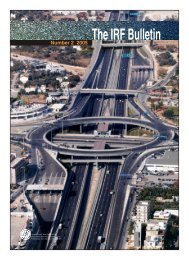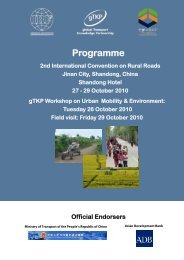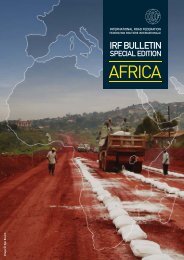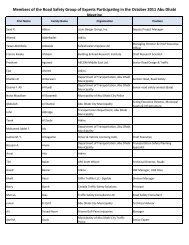TRANSPORT
TRANSPORT
TRANSPORT
- No tags were found...
Create successful ePaper yourself
Turn your PDF publications into a flip-book with our unique Google optimized e-Paper software.
SHARING THE ROAD<br />
SHARING THE ROAD<br />
The Impact of Motorcycle<br />
Taxis on Socio-Economic<br />
Development<br />
Paul Starkey<br />
Consultant in Integrated Transport Services<br />
Numbers of motorcycles (including mopeds and scooters)<br />
are increasing rapidly in many countries, often due to<br />
imports of inexpensive Chinese models. Motorised threewheelers<br />
are also slowly increasing. Motorcycles offer<br />
many benefits for rural people – providing greater access,<br />
mobility and employment opportunities. As motorcycles<br />
increase, niche markets arise spontaneously for motorcycle<br />
transport services. The profitability of motorcycle taxis<br />
often leads to rapid expansion. Transport authorities and<br />
local governments are often unprepared for the regulatory<br />
implications of motorcycle taxis and prohibit them. There is<br />
need for greater understanding and constructive regulation<br />
of these services.<br />
Rural and urban transport patterns<br />
The pattern of motorcycle adoption and motorcycle taxi<br />
services varies greatly between and within countries.<br />
Countries with rapid adoption of motorcycles include the<br />
very different socio-economic settings of Afghanistan,<br />
India, Indonesia, Vietnam, Colombia, Haiti, Benin, Nigeria<br />
and Rwanda. Countries with little use of motorcycles,<br />
and with similarly contrasting situations, include the USA,<br />
Cuba, South Africa, Ethiopia, Gabon and Fiji. Developing<br />
countries with little present use should prepare for possible<br />
rapid expansion. Tanzania had few motorcycles in 2005,<br />
but conditions seemed appropriate (Starkey, 2008) and, by<br />
2009, motorcycle taxis had started in several towns.<br />
Within countries, the adoption of motorcycles and<br />
motorcycle taxis is variable, but with clear patterns. Initial<br />
adoption starts in urban and peri-urban areas where<br />
imported motorcycles arrive. Here, there are funds to<br />
purchase them and economic transport demand. Once a<br />
critical mass of motorcycle users and supporting services<br />
develops, adoption becomes easier, and prices fall in<br />
Motorcycles successfully crossing riverbed in Timor-Leste<br />
IRF BULLETIN SPECIAL EDITION: RURAL <strong>TRANSPORT</strong>, VOLUME-2 VOLUME-1 | 17
















